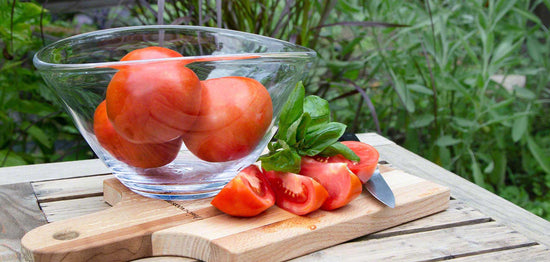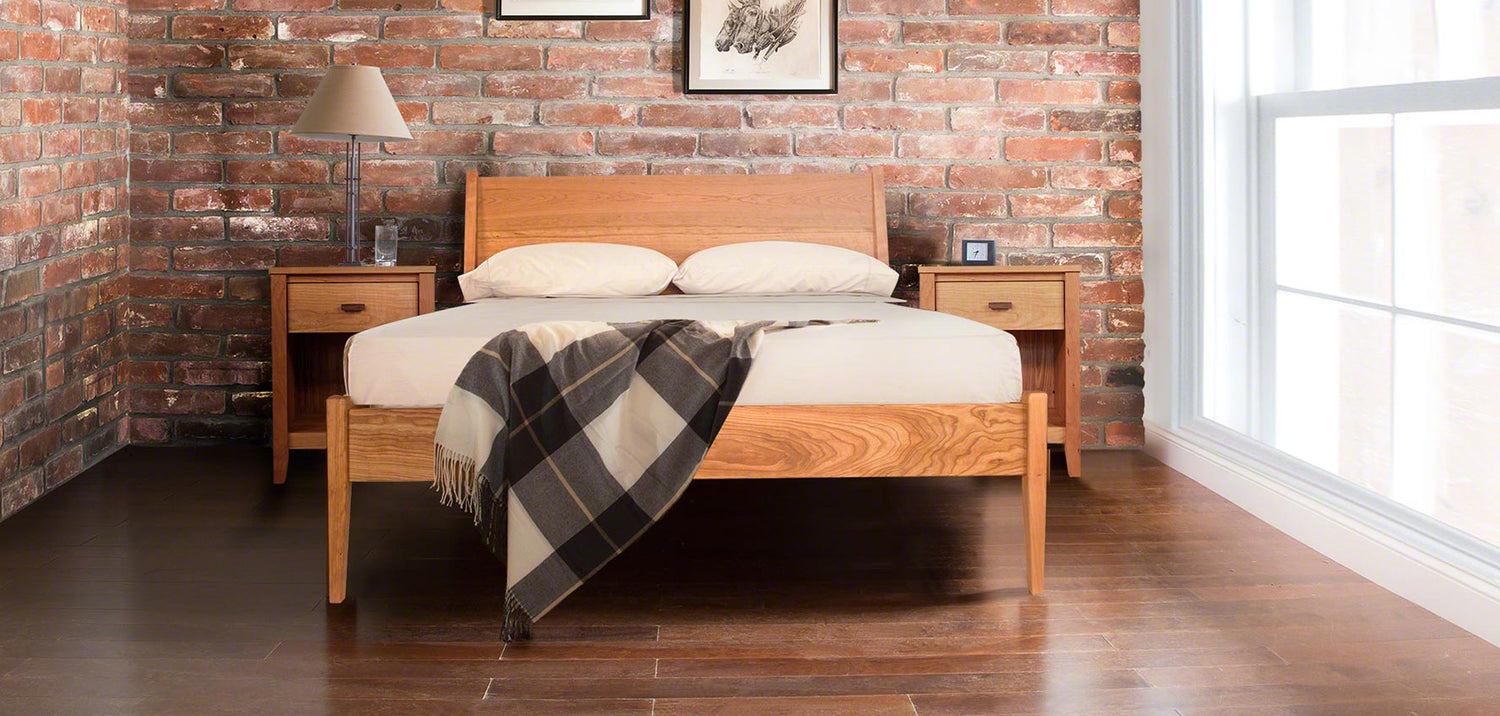Linseed Oil
Linseed oil, also known as flaxseed oil, is one of the most popular wood finishes in the world. Like other hand-rubbed oil finishes, linseed oil saturates deep into the wood grain to protect against scratches and changes in humidity. It is easy to care for, eco-friendly, and produces a satin finish that really brings out the color and grain of the wood underneath.
Often replaced by synthetic alkyd resins (lacquer, polyurethane, and varnish) for the past several decades, linseed oil is coming back in force lately, much in thanks to its non-toxicity and its environmentally friendly characteristics. Unlike those synthetic alkyds, oil finishes- including linseed oil- seep into the grain of the wood rather than forming a film on top of it.
Where Does Linseed Oil Come From?
Linseed oil is derived from the seeds of the flax plant (Linum usitatissimum). The flax plant has been cultivated commercially for textile, seeds, and oil for over 20,000 years. The plants fibers are processed into rope, canvas, paper, and linen, which is often found in bed sheets, table cloths, and clothing. The seeds are used as a nutritional supplement and processed further to produce flax oil (also known as linseed oil).
Common Uses of Linseed Oil
We know linseed oil as a popular wood finish, but it actually has several other applications. Some of the common uses of linseed oil are:
- As a finish to preserve wood products, especially those that come in contact with food (ie. cutting boards, wood bowls, etc)
- As a nutritional supplement with many health benefits
- As an additive in oil paint that enhances color and workability
- As a means to clean paint brushes
- As a polish and anti-rust agent for metals
- As a conditioner and cleaner for leather products
Types of Linseed Oil (Raw vs Boiled vs Polymerized)
Raw linseed oil is the purest form, but is sometimes impractical as a furniture finish due to the extended drying times- it can take several weeks for each coat of raw linseed oil to cure. Boiled linseed oil is common as a wood finish, but contains some potentially hazardous drying compounds. Polymerized linseed oil is the best of both worlds: pure and non-toxic with quick drying times.
Raw Linseed Oil is the purest, most natural form of the oil. It is the kind used in nutritional supplements and as a conditioner for leather (usually mixed with something to quicken curing time). Raw linseed oil makes a great finish for wood products if applied in thin coats and given plenty of time to cure, but it can take 2-10 weeks to fully dry depending on the environment and the thickness of the application.
Many craftsmen migrate toward polymerized or boiled linseed oil or some other alternative like tung oil if they dont have the patience or space to allow for ample drying time.
Polymerized Linseed Oil is created by heating raw linseed oil in the absence of oxygen to about 300°C (572°F) over the course of several days. During this process, a polymerization reaction occurs, which increases the oils viscosity and decreases the drying time. Both polymerized linseed oil and raw linseed oil contain zero VOCs (volatile organic compounds).
Boiled Linseed Oil, often written as BLO, is not as it sounds; there's no heating or boiling involved (unlike polymerized linseed oil). The difference between raw linseed oil and boiled linseed oil is that there are drying agents (either petroleum-based or heavy metals) added in order to make it a more feasible option for finishing wood furniture.
Some of the petroleum-based compounds that are added to linseed oil to decrease the drying time are naptha, mineral spirits, and dipropylene glycol monomethyl. Cobalt and manganese are the most common metal additives found in boiled linseed oil.
Because of the drying compounds added to boiled linseed oil, it is the least food-safe of the three mentioned and emits some VOCs while drying. Boiled linseed oils often carry the following warning as required by the state of California:
Warning: This product contains a chemical known to cause cancer and birth defects or other reproductive harm.
Note: If youre buying furniture with a boiled linseed oil finish, we highly recommend you check with the craftsman to better understand the composition of the oil. Ask for the brand of the finish used and skim through the MSDS spec sheet to see what sort of chemicals and warnings are associated with the use.
Pros & Cons of Linseed Oil as a Wood Finish
-
Pros
- Brings out depth of color and texture in wood grain
- Scratches & dents can be easily sanded out
- Non-toxic and eco-friendly
- Penetrates deep into the grain and protects well against changes in humidity
- Can be used alongside other finishes like wax in order to further protect the wood furniture
-
Cons
- Requires occasional re-oiling
- Susceptible to water rings
- The wood is more susceptible to scratches than a lacquer or varnish (however hard coat finishes are susceptible to surface scratches, which are more difficult to repair)
- Yellows slightly over time
- Changes in temperature or humidity may cause wood to bleed oil
- Susceptible to staining if colored liquids seep into wood
Linseed Oil vs Danish Oil vs Tung Oil
As discussed above, linseed oil comes in different varieties. Raw, polymerized, and boiled linseed oil are all derived from the flaxseed plant, but have been processed differently and to varying degrees. As a wood finish, linseed oil often gets compared to danish oil and tung oil.
Both tung oil and danish oil are terms that are often misused and misunderstood.
Tung oil is another popular wood finish that is derived from the seeds of the tung tree. It originates in Eastern Asia and has been used as a wood finish for thousands of years. Pure tung oil dries faster than raw linseed oil and doesnt carry the same yellowing effect, making it a good substitute for linseed oil on maple furniture. It is eco-friendly, non-toxic, and food-safe. It also dries into a much harder finish than linseed oil and is more water resistant. Tung oil generally requires 5 or more coats in order to fully saturate and protect wood furniture. We recommend using 100% pure tung oil, as it is often sold as a mixture of other compounds.
Danish oil is difficult to define. There is no consensus composition for danish oil. It is basically a catch-all term that encompasses any sort of hand-rubbed finish that isnt 100% pure. Danish oil often contains tung oil or linseed oil along with several other ingredients thickeners, thinners, drying agents, binding compounds, and more. Usually, danish oil finishes are a mixture of some time of varnish with either tung oil or linseed oil. If youre purchasing wood furniture with a danish oil finish, we recommend checking with the craftsman to see what brand of danish oil they use and doing a bit of research to make sure it will work for your lifestyle.
Linseed Oil FAQ's
Does Linseed Oil Change the Color of Wood?
Does Linseed Oil Change the Color of Wood?
Linseed oil does change the color of wood slightly. It carries a golden-brown hue and yellows slightly over time. This can bring out and highlight inherent color within the wood, but it also means its not an ideal finish for light colored woods like maple and ash.
Is Linseed Oil Toxic?
Is Linseed Oil Toxic?
Raw linseed oil is non-toxic and completely food-safe. It is often given as a health supplement in both people and animals, including dogs, horses, and more.
Is Linseed Oil Flammable?
Is Linseed Oil Flammable?
Linseed oil is flammable. If used and stored correctly, there is very little risk of linseed oil spontaneously combusting. However, the fire hazard increases under certain circumstances. Be very careful with rags that have been used to apply linseed oil. These are often known to start fires with no external spark. Used rags should be stored in a metal can with a top and soaked with water to limit the risk of fire since the drying process is exothermic.
Is Linseed Oil Waterproof?
Is Linseed Oil Waterproof?
Linseed oil is inherently water repellant (hydrophobic). However, when used as a wood finish, linseed oil can be susceptible to water damage. Try to avoid putting cold glasses on oiled furniture without coasters, and if the oiled surface does get wet, wipe it dry as soon as possible.
Linseed Oil Be Used on Cutting Boards?
Linseed Oil Be Used on Cutting Boards?
Yes, linseed oil is a popular finish for wood cutting boards and wood kitchen products. It is non-toxic and food friendly. We also recommend food-grade mineral oil, which is sometimes referred to as Butcher Block Oil.
How Do You Maintain an Oil Finish?
How Do You Maintain an Oil Finish?
Re-oiling when the finish appears dry, which will be dependant on the type of wood, temperature and humidity. Scratches and dents can be sanded out with a piece of high grit sandpaper or steel wool. Learn more about caring for your furniture.
Read More on the Blog
-
Linseed Oil vs Tung Oil: What's the Difference?
Read MoreBoth linseed oil and tung oil– in their purest forms– are non-toxic, eco-friendly, and food-safe.
-
Raw vs Boiled vs Polymerized Linseed Oil
Read MoreRaw linseed oil is the purest form, but is sometimes impractical as a furniture finish due to the extended drying times
-
What is Boiled Linseed Oil?
Read MoreThe difference between raw linseed oil and boiled linseed oil is that there are drying agents added to BLO to shorten the time it takes for the oil to cure.
-
5 of the Best Oil Finishes for Wood Furniture
Read MoreOil finishes are eco-friendly, food-safe, and non-toxic. They're also easy to repair and produce a more textured grain pattern than many alternatives.
-
Common Wood Finishes for Furniture & Flooring
Read MoreThere are lots of options for finishing wood, but when it comes to furniture and flooring, most products fall into one of these five categories.
Other Types of Wood Finishes
-

Tung Oil
More About Tung Oil -

Mineral Oil
More About Mineral Oil -

Lacquer
More About Lacquer




